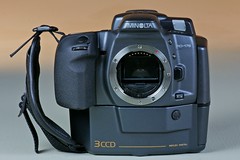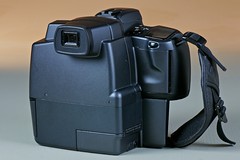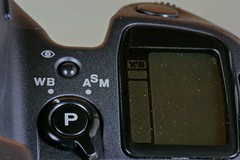Difference between revisions of "Minolta RD-175"
m (Rephrased a couple of sentences. Put into consistent present tense.) |
|||
| Line 6: | Line 6: | ||
|colspan=3|images by Mikel Adell {{with permission}} | |colspan=3|images by Mikel Adell {{with permission}} | ||
|}{{br}} | |}{{br}} | ||
| − | The '''Minolta RD-175''' (also sold as the '''Agfa Actioncam''') | + | The '''Minolta RD-175''' (also sold as the '''Agfa Actioncam''') is one of the first digital [[SLR]] cameras. When [[Minolta]] introduced this camera in 1995 it cost around $10,000 US, and was inaccessible to Minolta's usual base of amateur photographers. It was intended for professional markets (including medical, insurance, and scientific) in which Minolta had made scant little inroads at the time. |
| − | Minolta engineers used a costly | + | Minolta engineers used a costly trick to get acceptable colour pictures in 1.75 [[megapixel|mega-pixel]] resolution: |
| − | 1 - Relay optics reduce the image size from Minolta's normal 35mm SLR lenses from 36 x 24mm to 16 x 12 mm, about | + | 1 - Relay optics reduce the image size from Minolta's normal 35mm SLR lenses from 36 x 24mm to 16 x 12 mm, about 0.5x, (doubling the effective focal length) and reducing the widest effective aperture to f/6.7. |
| − | 2 - The light | + | 2 - The light from the lens is split using a dichroic prism block into the required colour components for each sensor. Each part was projected onto its own [[CCD|CCD light-sensor]]. |
| − | 3 - | + | 3 - The camera has ''two'' green sensors, and one red/blue combination sensor, which is striped using microscopic filter elements. This made the camera back huge compared to film SLRs. Each CCD has a resolution of 768 x 494 pixels on 6.4 x 4.8 mm chips (~3.6% by area, or ~19% by linear measure, of the size of a 35mm frame). |
| − | 4 - The three images | + | 4 - The three images are digitally integrated and enlarged to 1,528 x 1,146 pixels by interpolation (~1.5x). The resulting 1.75 megapixel images are stored on a PCMCIA type III hard disk card. |
| + | |||
| + | The handling of the camera is almost like that of other autofocus SLR cameras of the time, and the lenses for this camera are the same as those for Minolta's Alpha/Dynax/Maxxum film SLR camera bodies. The picture quality, once praised, is far behind that of [[Konica Minolta]]'s later digital SLRs using Sony's single-chip 6 mega-pixel resolution sensor. | ||
| − | |||
== Links == | == Links == | ||
Revision as of 17:30, 17 January 2012

|

|

|
| images by Mikel Adell (Image rights) | ||
The Minolta RD-175 (also sold as the Agfa Actioncam) is one of the first digital SLR cameras. When Minolta introduced this camera in 1995 it cost around $10,000 US, and was inaccessible to Minolta's usual base of amateur photographers. It was intended for professional markets (including medical, insurance, and scientific) in which Minolta had made scant little inroads at the time.
Minolta engineers used a costly trick to get acceptable colour pictures in 1.75 mega-pixel resolution:
1 - Relay optics reduce the image size from Minolta's normal 35mm SLR lenses from 36 x 24mm to 16 x 12 mm, about 0.5x, (doubling the effective focal length) and reducing the widest effective aperture to f/6.7.
2 - The light from the lens is split using a dichroic prism block into the required colour components for each sensor. Each part was projected onto its own CCD light-sensor.
3 - The camera has two green sensors, and one red/blue combination sensor, which is striped using microscopic filter elements. This made the camera back huge compared to film SLRs. Each CCD has a resolution of 768 x 494 pixels on 6.4 x 4.8 mm chips (~3.6% by area, or ~19% by linear measure, of the size of a 35mm frame).
4 - The three images are digitally integrated and enlarged to 1,528 x 1,146 pixels by interpolation (~1.5x). The resulting 1.75 megapixel images are stored on a PCMCIA type III hard disk card.
The handling of the camera is almost like that of other autofocus SLR cameras of the time, and the lenses for this camera are the same as those for Minolta's Alpha/Dynax/Maxxum film SLR camera bodies. The picture quality, once praised, is far behind that of Konica Minolta's later digital SLRs using Sony's single-chip 6 mega-pixel resolution sensor.
Links
- RD-175/Agfa Actioncam review by John Henshall
- Agfa Actioncam on Jarle Aasland's NikonWeb.com site
- Minolta RD-175 English 6 page PDF quick guide @ Mike Butkus' www.orphancameras.com
- Example images at Pbase.com